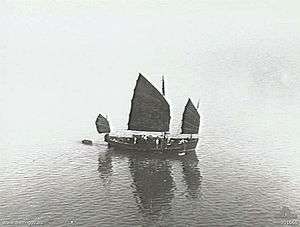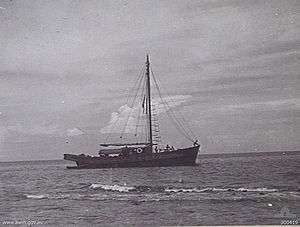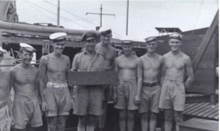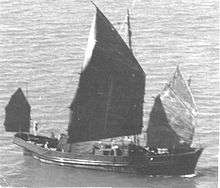Snake-class junk
 HMAS River Snake in May 1945 | |
| Class overview | |
|---|---|
| Name: | Snake class |
| Builders: |
|
| Operators: | Royal Australian Navy, Australian Army |
| Built: | 1944–1945 |
| In service: | 1944–1945 |
| Planned: | 7 |
| Completed: | 6 |
| Cancelled: | 1 |
| Active: | 0 |
| General characteristics | |
| Type: | Junk |
| Displacement: | 80 tons (gross) |
| Length: | 66 ft (20 m) |
| Beam: | 17 ft (5.2 m) |
| Draught: | 7.6 ft (2.3 m) |
| Propulsion: | Gray Marine 64 YTL diesel, single screw, 300 horsepower (220 kW) |
| Speed: | 9 knots (17 km/h; 10 mph) |
| Range: | 500 nautical miles (930 km; 580 mi) |
| Capacity: | 20 tons of cargo |
| Crew: | 9 |
| Armament: |
|
| Notes: | Ships' characteristics from Corvettes. Australia's Naval Patrol Forces. Photofile No. 10, p. 48[1] |
The Snake-class junks were a class of six vessels operated by the Royal Australian Navy (RAN) to support special forces operations in 1944 and 1945. The ships were lightly armed and were used to infiltrate special forces parties and their supplies into Japanese-held territory.
Service history

When the Services Reconnaissance Department's (SRD) naval section was established in January 1944 it was equipped with only two vessels to transport special forces parties and their supplies behind Japanese lines. In order to make up this deficiency four trawler-type ships which were being built at Williamstown, Victoria for the Australian Army were transferred to SRD on 26 March 1944. The superstructure of these vessels was modified so that they appeared similar to the junks operated in the Singapore area. A further two vessels were later built at Fremantle, Western Australia and a fifth Williamstown-built ship was cancelled at the end of the war. While all six ships were commissioned into the RAN, their nine-man crews were drawn from the Navy and other services.[1]
The Snake-class vessels relied on stealth to penetrate into Japanese territory. They were lightly armed with two Oerlikon 20 mm cannons and three or four M2 Browning machine guns or Bren Guns for defensive purposes only. They could also carry up to 20 tons of cargo stored below decks.[1]
The Snake-class vessels commenced operations in late 1944 and operated from bases at Darwin, Morotai, New Guinea, the Philippines and Borneo. Four of the class (Tiger Snake, Black Snake, Sea Snake and River Snake) undertook operations in Japanese territory, and these ships completed only eleven missions before the end of the war. The Australian military did not require the Snake class after Japan's surrender, and all but Diamond Snake were transferred to the British Borneo Civil Administration Unit between November and December 1945. Diamond Snake was transferred to the Australian Army on 19 October that year.[1]
Ships in class

The seven Snake-class vessels were:[2]
| Ship | Builder | Commissioned | Decommissioned | Notes |
|---|---|---|---|---|
| HMAS Black Snake | J.J. Savage and Sons, Williamstown | 30 December 1944 | 3 November 1945 | |
| HMAS Coral Snake | J.J. Savage and Sons, Williamstown | Cancelled while under construction in August 1945[3] | ||
| HMAS Diamond Snake | J.J. Savage and Sons, Williamstown | 23 July 1945 | 19 October 1945 | Transferred to the Australian Army |
| HMAS Grass Snake | Millars Bunnings Shipbuilding, Fremantle | 23 April 1945 | 13 December 1945 | Commanded by S/LT John Preston Gowing at some point date unclear see service record below. |
| HMAS River Snake | Millars Bunnings Shipbuilding, Fremantle | 19 February 1945 | 2 November 1945 | Commanded by S/LT John Preston Gowing |
| HMAS Sea Snake | J.J. Savage and Sons, Williamstown | 31 March 1945 | 27 November 1945 | |
| HMAS Tiger Snake | J.J. Savage and Sons, Williamstown | 22 August 1945 | 3 November 1945 | |


Notes

References
- Corvettes. Australia's Naval Patrol Forces. Photofile No. 10. Marrickille: Topmill. 2001. ISBN 1876860219.
- Lind, Lewis James (1988). Fair Winds to Australia: 200 Years of Sail on the Australia Station. Reed. ISBN 0730102165.